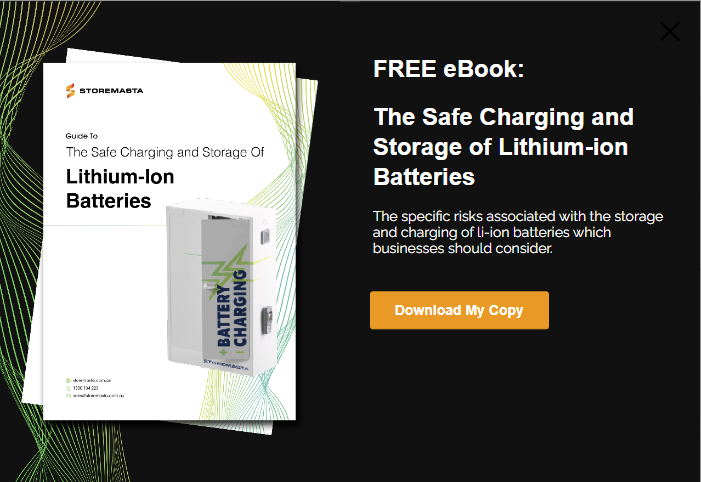In the majority of workplaces in Australia, staff rely on lithium-ion batteries to power a range of devices and equipment. From laptops to mobile phones and industrial robots to medical devices, lithium-ion batteries are a necessary energy supply for a vast range of products. However, if you’re not using, charging or storing your lithium-ion batteries in the correct way you could be risking thermal runaway. But what is thermal runaway and how can it impact the safety of your people, your property and your organisation? This blog looks at lithium-ion batteries and explains how thermal runaway can occur in the workplace — and how you can reduce the risk.
What Is Thermal Runaway?
Put in the simplest of terms, thermal runaway in lithium-ion batteries is an overheating of the battery cell which results in a chemical reaction.
This process occurs when the temperature within the battery cell exceeds a certain point — that is, the heat generated is greater than the heat that is dispersed. This process will continue with the heat of the battery cell increasing until it sparks a chemical reaction.
The elevated temperatures produce an exothermic decomposition of the battery cell. This means that the substance decomposes with a positive feedback loop (amplifying instability) and this produces thermal runaway.
Temperatures in lithium-ion battery cells can rise very quickly. In fact, the temperature can significantly rise within mere milliseconds. Once this process starts to occur, it is very difficult to stop.

Take care to avoid overcharging of your lithium-ion batteries as this can result in thermal runaway.
If you notice your batteries overheating, you should immediately disconnect them from the power source. However, there are other preventative measures that you can implement to reduce the risk of thermal runaway occurring in your lithium-ion battery stores.
What Happens When Thermal Runaway Occurs?
Lithium-ion batteries are known for their exceptional performance and higher charge and discharge currents. However, as a rechargeable battery, their ability to produce heat has lead to incidents such as fire and explosion.
This can happen in almost any setting — from the office to the factory floor and even during transport. In fact, since the early 1990s, hundreds of passenger and cargo planes have suffered a fire or explosion due to the lithium-ion batteries that they were carrying. Due to this risk, airlines require passengers to restrict the amount of batteries they carry on to the flight. Airlines do not allow batteries to be stored in checked baggage.
Thermal runaway in lithium-ion batteries can cause a range of issues from minor to severe.
Hazards may include:
- Melting batteries
- Irreversible damage to the battery cell
- Gassing of the battery
- Extremely hot fires
- Explosion
When you’re carrying lithium-ion batteries in your workplace, you must also be aware that thermal runaway in a single battery can affect the other batteries that you’re storing nearby.
If a single lithium-ion battery overheats, it can quickly create an incident of thermal runaway occurring in batteries that are stored nearby. This domino effect will amplify the likelihood and impact of a fire or explosion —causing severe damage to your organisation, your staff and your surrounds.
How Does Temperature Affect Lithium-Ion Batteries?
The temperature for storing lithium-ion batteries can affect the safety of the product. Extreme cold or heat will result in damage to the battery, as well as a reduction in its performance. Therefore, you must ensure that your lithium-ion batteries are stored, charged and discharged in an environment that is not prone to extreme temperatures.
You should always refer to the battery manufacturer’s guidelines on the operational temperature range for your batteries. However, the provision of indoor storage, temperature control and adequate ventilation can assist with the safe storage of lithium-ion batteries.

The temperature of the storage facility for your lithium-ion batteries must be at a level that does not compromise the safety of your battery.
The Risk Of A Workplace Fire Sparking Thermal Runaway
Due to the risk of ambient heat causing thermal runaway in lithium-ion batteries, you should also have risk control measures in place to prevent (or slow down) workplace fires. Due to the elevated temperature, the fire will quickly ignite any batteries that you have onsite.
Without any control measures, the batteries will only add to the intensity of the fire and increase the risk for your business and community.
Interested in improving battery safety?
Storing batteries in a dedicated cabinet that can prevent fire from affecting the batteries can give your organisation time to action firefighting equipment or call emergency services. You should make sure that your battery cabinets are equipped with thermal protection features such as double-walled steel construction, a space of at least 40 mm between walls, and self-closing, close fitting doors.
How Can You Minimise The Risk Of Thermal Runaway In Your Business?
Whether it’s a fault in the battery, overcharging or poor storage practices, there are many factors which can increase the risk of thermal runaway occurring in lithium-ion batteries.
Some simple things you can do to reduce this risk is ensuring your batteries are in good condition. You must also make sure that your batteries are not overcharged, and that they are handled and stored in the correct manner.

To avoid thermal runaway, you should avoid overcharging and overheating your batteries.
Where and how you store your lithium-ion batteries can impact their safety. You should consider the following storage requirements to reduce the risk of thermal runaway:
- Adequate ventilation and temperature control to maintain a safe ambient temperature
- Only charging batteries with chargers that meet Australian manufacturing standards
- Any electrical work for the power points must be safe and compliant to avoid excessive currents when charging or discharging
You should also make sure that your staff know how to:
- Monitor the batteries when charging to avoid overcharging
- Carefully handle the batteries and avoid knocking or dropping them
- Dispose of batteries which aren’t in good working order
- Schedule preventative maintenance (1 or 2 times a year)
Educating Staff About The Risks Associated With Lithium-Ion Batteries
When dealing with any type of Dangerous Good, it’s always crucial that staff are aware of the risks involved with their use. Staff should be trained in the safe handling, storing or charging of batteries. This will help ensure stability on both a thermal and mechanical level.
Having a dedicated space to store and charge your lithium-ion batteries is an important risk control measure that offers a range of benefits including impact protection, fire and heat prevention and temperature control.
However, it’s also important for staff to understand how dangerous it can be for a lithium-ion battery to be impacted by a falling tool or struck by a vehicle. Accidental damage to the battery, such as a hit or knock, can directly result in thermal runaway.
Staff should be instructed to discard any old or damaged batteries. There should also be procedures in place to prevent overcharging in lithium-ion batteries.
When dealing with any class of Dangerous Goods, you should always have clear emergency procedures in place, so your staff know how to react if a lithium-ion battery fire does break out.
Storing and Charging Lithium-Ion Batteries
As we’ve outlined in this blog, there are many preventative measures that you can put in place to reduce the risk of thermal runaway in your lithium-ion batteries. Being aware of the temperature sensitivity of the battery, protecting your batteries from impact damage, implementing control measures to address the risk of workplace fires and maintaining your battery supplies are all important factors to consider.
While lithium-ion batteries are a common energy source in homes and businesses, they are still classed as Class 9 Dangerous Goods. Awareness of the risks associated with the handling, storing and charging of batteries can reduce the likelihood of fires and explosions. If you’d like to learn more about reducing risk in your workplace, with lithium-ion batteries or any class of Dangerous Goods, we have a guide that can help. The Safe Charging and Storage of Lithium-ion Batteries is an easy-to-understand eBook that details our proven 4-step risk control methodology — with an emphasis on the monitoring and reviewing of control measures, such as a battery charging cabinet. This risk control methodology can be quickly applied to your own workplace, so you can take the next steps towards reducing the risk of thermal runaway, fire and explosion. Grab your free copy today.
Joining the team as a Dangerous Goods Storage Consultant, Melissa Hampton became Storemasta's Marketing Manager in late 2021. With extensive knowledge and experience in chemical compliance, Melissa is responsible for leading the Marketing team and helping shape their marketing strategy. In her spare time, you can find Melissa hiking, swimming and enjoying the great outdoors in beautiful north-west Tasmania.
